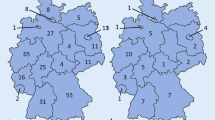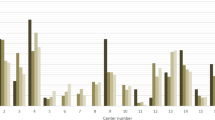Abstract
Background
Chest pain units (CPUs) and stroke units (SUs) provide specialized multidisciplinary in-hospital management for acute chest pain and ischemic stroke. We analyzed exemplary equivalent quality benchmarks in both concepts.
Material and methods
Data from the German CPU registry (2012–2015; 45 certified CPUs, 5881 patients) were compared with data from the SU registry of Rhineland-Palatinate (2011–2015; 29 SUs; 40,380 patients). Parameters comprised demographics, symptoms, diagnosis, medication, critical time intervals, therapeutics, and in-unit outcome.
Results
Non-ST-segment elevation myocardial infarction (47.4%) and ischemic stroke (63.0%) were the most frequent entities. An electrocardiogram was performed on average within 7 min in CPUs, cranial imaging within 49 min in SUs. The mean time interval from admission until coronary intervention or lysis was 42 min or 57 min, respectively. Rates of antiplatelet therapy (90.1% vs. 96.0%), brain imaging, and coronary angiography were high (99.3% vs. 81.1%) and the mortality was low (0.8% for CPUs vs. 3.6% for SUs). The length of stay was shorter in CPUs (1.5 days vs. 4.4 days).
Conclusion
As reimbursement for emergency medicine in Germany was recently rearranged, quality benchmarking has gained incremental importance. Mandatory joint quality measurement in both concepts ensuring gap analysis and process improvement is encouraged.
Zusammenfassung
Hintergrund
Chest Pain Units (CPU) und Stroke Units (SU) bieten eine spezialisierte, multidisziplinäre stationäre Versorgung bei akutem Brustschmerz bzw. ischämischem Schlaganfall. Die Autoren untersuchten in der vorliegenden Studie exemplarisch korrespondierende Qualitätsmarker für beide Konzepte.
Material und Methoden
Daten aus dem deutschen CPU-Register (2012–2015; 45 zertifizierte CPU, 5881 Patienten) wurden mit Daten aus dem Qualitätssicherungsprojekt Schlaganfallversorgung Rheinland-Pfalz (2011–2015; 29 SU; 40.380 Patienten) verglichen. Zu den untersuchten Parametern zählten Demografie, Symptome, Diagnosen, Medikation, kritische Zeitintervalle, therapeutische Maßnahmen sowie das innerklinische Outcome.
Ergebnisse
Der Nicht-ST-Strecken-Hebungs-Infarkt (47,4 %) und der ischämische Schlaganfall (63,0 %) waren die häufigsten Entitäten. Ein EKG wurde im Mittel binnen 7 min geschrieben, die zerebrale Bildgebung innerhalb von 49 min durchgeführt. Die mittlere Dauer zwischen Aufnahme und Herzkatheteruntersuchung bzw. Lysetherapie betrug 42 bzw. 57 min. Die Raten für Therapie mittels Plättchenhemmung (90,1 vs. 96,0 %), Herzkatheteruntersuchung (81,1 %) und zerebrale Bildgebung (99,3 %) waren hoch, wohingegen die Mortalität niedrig war (0,8 % in den CPU vs. 3,6 % in den SU). Die Dauer des Aufenthalts in den SU war mit 4,4 Tagen länger als in den CPU (1,5 Tage).
Schlussfolgerung
Nicht zuletzt infolge der Neuregelung zur Vergütung in der Notfallmedizin in Deutschland gewinnt die strukturierte Qualitätskontrolle zunehmend an Bedeutung. Ein verpflichtendes, gemeinsames Benchmarking zur Lückenanalyse und Prozessoptimierung sollte forciert werden.
Similar content being viewed by others
References
Münzel T, Heusch G (2017) Chest pain unit network in Germany: its effect on patients with acute coronary syndromes. J Am Coll Cardiol 69(19):2459–2460
Stroke Unit Trialists’ Collaboration (2013) Organised inpatient (stroke unit) care for stroke. Cochrane Database Syst Rev 11(9):CD197
Post F, Gori T, Giannitsis E et al (2015) Criteria of the German society of cardiology for the establishment of chest pain units: update 2014. Clin Res Cardiol 104(11):918–928
Nabavi DG, Koennecke HC, Ossenbrink M et al (2018) Certification criteria for stroke units in Germany: update 2018. Nervenarzt. https://doi.org/10.1007/s00115-018-0633-y
Varnavas V, Rassaf T, Breuckmann F (2018) Nationwide but still inhomogeneous distribution of certified chest pain units across Germany: need to strengthen rural regions. Herz 43(1):78–86
Seidel G, Hermanek P, Kolominsky-Rabas P et al (2014) The quality of acute stroke care—an analysis of evidence-based indicators in 260 000 patients. Dtsch Arztebl Int 111(45):759–765
Vafaie M, Hochadel M, Münzel T et al (2018) Guideline-adherence regarding critical time intervals in the German chest pain unit registry. Eur Heart J Acute Cardiovasc Care. https://doi.org/10.1177/2048872618762639
Hillmann S, Wiedmann S, Rücker V et al (2017) Stroke unit care in Germany: the German stroke registers study group (ADSR). BMC Neurol 17(1):49
Grau AJ, Eicke M, Biegler MK et al (2010) Quality monitoring of acute stroke care in Rheinland-Pfalz, Germany, 2001–2006. Stroke 41(7):1495–1500
Breuckmann F, Rassaf T (2016) First update of the criteria for certification of chest pain units in Germany: facelift or new model. Crit Pathw Cardiol 15(1):29–31
Grau AJ, Eicke M, Burmeister C et al (2018) Follow-up 90 days after stroke and TIA in the stroke quality monitoring project Rheinland-Pfalz. Akt Neurol 45(9):636–645
O’Rourke F, Chan DK, Chan DL et al (2013) Preferences, barriers and facilitators for establishing comprehensive stroke units: a multidisciplinary survey. Aust Health Rev 37(3):318–323
Beerheide R (2019) Notfallstufenkonzept: Drei Stufen für die Notfallversorgung. Dtsch Arztebl 116(3):A–64–C–56
Post F, Giannitsis E, Riemer T et al (2012) Pre- and early in-hospital procedures in patients with acute coronary syndromes: first results of the “German chest pain unit registry”. Clin Res Cardiol 101(12):983–991
Breuckmann F, Hochadel M, Darius H et al (2015) Guideline-adherence and perspectives in the acute management of unstable angina—initial results from the German chest pain unit registry. J Cardiol 66(2):108–113
Breuckmann F, Hochadel M, Voigtländer T et al (2017) On- versus off-hour supply in acute coronary syndromes with persistent ST-segment elevation in certified German chest pain units. Eur Heart J Acute Cardiovasc Care 6(1):3–9
Schmidt FP, Schmitt C, Hochadel M et al (2018) Invasive treatment of NSTEMI patients in German chest pain units—evidence for a treatment paradox. Int J Cardiol 255:15–19
Nowak B, Giannitsis E, Riemer T et al (2012) Self-referral to chest pain units: results of the German CPU-registry. Eur Heart J Acute Cardiovasc Care 1(4):312–319
Waje-Andreassen U, Nabavi DG, Engelter ST et al (2018) European stroke organisation certification of stroke units and stroke centres. Eur Stroke J 3(3):220–226
Claeys MJ, Ahrens I, Sinnaeve P et al (2017) The organization of chest pain units: position statement of the acute cardiovascular care association. Eur Heart J Acute Cardiovasc Care 6(3):203–211
Author information
Authors and Affiliations
Corresponding author
Ethics declarations
Conflict of interest
F. Breuckmann, M. Hochadel, A.J. Grau, T. Münzel, and J. Senges declare that they have no competing interests.
For this article no studies with human participants or animals were performed by any of the authors. All studies performed were in accordance with the ethical standards indicated in each case.
Additional information
All authors take responsibility for all aspects of the reliability and freedom from bias of the data presented and their interpretation.
Rights and permissions
About this article
Cite this article
Breuckmann, F., Hochadel, M., Grau, A.J. et al. Quality benchmarks for chest pain units and stroke units in Germany. Herz 46 (Suppl 1), 89–93 (2021). https://doi.org/10.1007/s00059-019-04881-3
Received:
Revised:
Accepted:
Published:
Issue Date:
DOI: https://doi.org/10.1007/s00059-019-04881-3
Keywords
- Coronary angiography
- Brain ischemia
- Non-ST elevated myocardial infarction
- Emergency medicine
- Acute coronary syndrome




